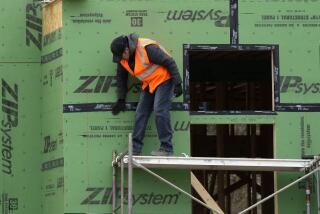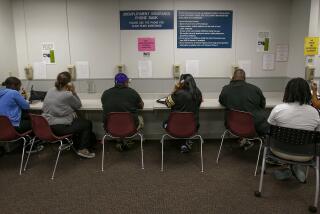Japan Could Be on the Way to a Recovery : Economy: Jobless rate hits a record high, but analysts say other indicators are encouraging.
- Share via
TOKYO — Japan’s jobless rate has risen to a record, but other barometers show its economy could be on the way to getting on its feet again.
Analysts said the mixed bag of data released Tuesday shows that although the economy has been moving in the direction of recovery, it may take some time to actually achieve it.
“The economy is gradually working its way to a recovery, but it’s too early to say it is actually on an upward trend,” said Toru Oshiro, an economist at the Yamaichi Research Institute of Securities and Economics.
The unemployment rate high, although bad news, does not necessarily mean there’s no prospect for a recovery, analysts said.
“Unemployment is a lagging indicator, so it’s more a sign of economic weakness in the past few months,” Oshiro said.
The jobless rate jumped to 3.4% in November, up from the previous record of 3.2% in October, a level it had maintained for five successive months.
The government’s chief economic planner, Isamu Miyazaki, had said in mid-November that real unemployment was more likely to be between 5% and 6%, much higher than the official rate. Official counts do not include those who have given up looking for a job or people who remain on company payrolls even when there is no work for them to do.
Some analysts pointed out that job offers have increased. The jobs-to-applicants ratio rose from 0.63 in November from 0.61 the month before. This means there were 63 job offers for every 100 applicants in November.
“It means that some jobs are being created, just not enough to go around,” said Chris Calderwood, senior economist at BZW Securities in Tokyo.
Meanwhile, the index of leading indicators showed significant improvement for the first time in six months, breaking the so-called boom or bust barrier of 50. The index, which predicts economic performance for the coming six months, rose to 80 in October against 36.4 in September.
The rise could be attributed to improvement in indicators relating to industrial output, analysts said, noting that machinery orders were up and that inventories were down when compared with the levels of three months ago.
Yet a recovery would not necessarily have a curative effect on the unemployment rate next year, analysts said.
“It will be higher in 1996 than it was in 1995,” Calderwood said.
The job-creation momentum is unlikely to be strong enough to bring the unemployment rate down, and many of the jobs created are probably part-time or short-term contract work, analysts said.
Analysts agreed that it would take until February or March before any full-blown economic recovery could be said to be underway.
More to Read
Sign up for Essential California
The most important California stories and recommendations in your inbox every morning.
You may occasionally receive promotional content from the Los Angeles Times.













